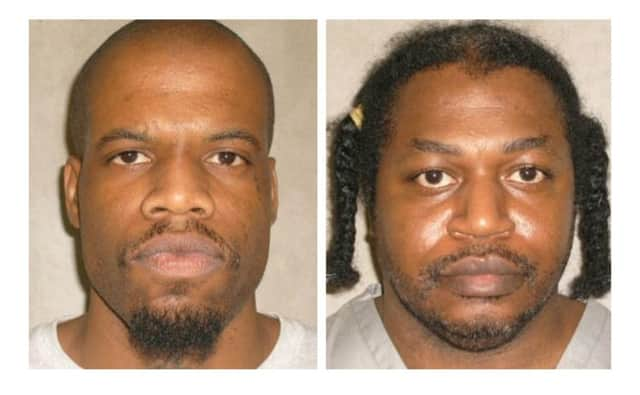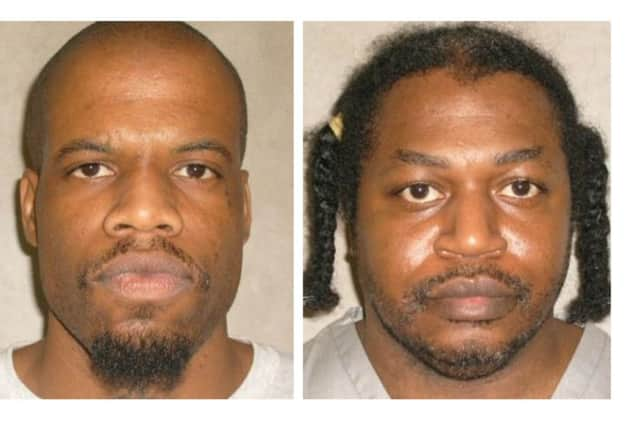Oklahoma: Man dies after botched execution


Clayton Lockett, 38, was declared unconscious 10 minutes after the first of the state’s new three-drug lethal injection combination was administered.
Three minutes later, though, he began breathing heavily, writhing, clenching his teeth and straining to lift his head off the pillow.
Advertisement
Hide AdAdvertisement
Hide AdThe blinds were eventually lowered to prevent those in the viewing gallery from watching what was happening in the death chamber, and the state’s senior prison official eventually called a halt to the proceedings.


Lockett died of a heart attack a short time later, the Department of Corrections said.
“It was a horrible thing to witness. This was totally botched,” said Lockett’s lawyer, David Autry.
The problems with the execution are likely to fuel more debate about the ability of states to administer lethal injections that meet the US Constitution’s requirement they be neither cruel nor unusual punishment.
That question has drawn renewed attention from defence lawyers and death penalty opponents in recent months, as several states scrambled to find new sources of execution drugs because drug firms that oppose capital punishment - many based in Europe - have stopped selling to prisons.
Defence lawyers have unsuccessfully challenged several states’ policies of shielding the identities of the new sources of their execution drugs.
Yesterday was the first time Oklahoma used the drug midazolam as the first element in its execution drug combination.
Other states have used it before - Florida administers 500 milligrams of midazolam as part of its three-drug combination. Oklahoma used 100 milligrams of that drug.
Advertisement
Hide AdAdvertisement
Hide Ad“They should have anticipated possible problems with an untried execution protocol,” Mr Autry said.
“Obviously the whole thing was gummed up and botched from beginning to end. Halting the execution obviously did Lockett no good.”
Republican Governor Mary Fallin ordered a 14-day stay of execution for an inmate who was scheduled to die two hours after Lockett, Charles Warner.
She also ordered the state’s Department of Corrections to conduct a “full review of Oklahoma’s execution procedures to determine what happened and why during this evening’s execution”.
Robert Patton, the department’s director, halted Lockett’s execution about 20 minutes after the first drug was administered. He later said there had been vein failure.
The execution began at 6.23pm local time, when officials began administering the first drug, the sedative midazolam. A doctor declared Lockett to be unconscious at 6.33pm.
Once an inmate is declared unconscious, the state’s execution protocol calls for the second drug, a paralytic, to be administered. The third drug in the protocol is potassium chloride, which stops the heart.
Patton said the second and third drugs were being administered when a problem was noticed and it is unclear how much of the drugs made it into the inmate’s system.
Advertisement
Hide AdAdvertisement
Hide AdLockett began writhing at 6.36. At 6.39, a doctor lifted the sheet that was covering the inmate to examine the injection site.
“There was some concern at that time that the drugs were not having that (desired) effect, and the doctor observed the line at that time and determined the line had blown,” Mr Patton said at a news conference, referring to Lockett’s vein rupturing.
After an official lowered the blinds, Mr Patton made a series of phone calls before calling a halt to the execution.
“After conferring with the warden, and unknown how much drugs went into him, it was my decision at that time to stop the execution,” Mr Patton said.
Lockett was declared dead at 7.06pm.
Mr Autry was immediately sceptical about the department’s claim that the issue was limited to a problem with Lockett’s vein.
“I’m not a medical professional, but Mr Lockett was not someone who had compromised veins,” he said. “He was in very good shape. He had large arms and very prominent veins.”
In Ohio, the January execution of an inmate who made snorting and gasping sounds led to a civil rights lawsuit by his family and calls for a moratorium.
The state has stood by the execution but said on Monday that it is boosting the dosages of its lethal injection drugs.
Advertisement
Hide AdAdvertisement
Hide AdA four-time felon, Lockett was convicted of shooting 19-year-old Stephanie Neiman with a sawed-off shotgun and watching as two accomplices buried her alive in rural Kay County in 1999 after Neiman and a friend arrived at a home the men were robbing.
Warner had been scheduled to be put to death two hours later in the same room and on the same gurney. The 46-year-old was convicted of raping and killing his roommate’s 11-month-old daughter in 1997. He has maintained his innocence.
Lockett and Warner had sued the state for refusing to disclose details about the execution drugs, including where Oklahoma obtained them.
The case, filed as a civil matter, placed Oklahoma’s two highest courts at odds and prompted calls for the impeachment of state Supreme Court justices after the court last week issued a rare stay of execution.
The high court later dissolved its stay and dismissed the inmates’ claim that they were entitled to know the source of the drugs.
By then, Ms Fallin had weighed into the matter by issuing a stay of her own - a one-week delay in Lockett’s execution that resulted in both men being scheduled to die on the same day.